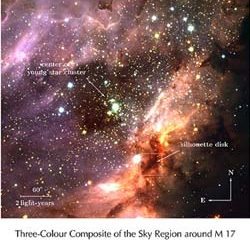This area deals with the fundamental laws and building blocks of nature and how they interact, the properties and the behavior of matter, and research into space and time and their structures.
innovations-report provides in-depth reports and articles on subjects such as astrophysics, laser technologies, nuclear, quantum, particle and solid-state physics, nanotechnologies, planetary research and findings (Mars, Venus) and developments related to the Hubble Telescope.

While the Cassini spacecraft has been flying toward Saturn, chemists on Earth have been making plastic pollution like that raining through the atmosphere of Saturn’s moon, Titan.
Scientists suspect that organic solids have been falling from Titan’s sky for billions of years and might be compounds that set the stage for the next chemical step toward life. They collaborate in University of Arizona laboratory experiments that will help Cassini scientists interpret Titan data and plan a futur

How dolphins evolved to fly like birds under water
Physicists in Japan have discovered how the surface of a dolphin’s skin reduces drag and helps them glide smoothly and quickly through water. These findings could help scientists design faster, energy-efficient boats, ocean liners, and submarines. This research is published in the Institute of Physics journal, Journal of Turbulence.
Scientists have known for some time that dolphins have evolved streamlined bodies which

Some nuclear fusion reactions inside stars occur more slowly than we thought and, as a consequence, stars themselves, as well as galaxies and the entire universe are a bit older than expected. This is what comes out from the last results of Luna experiment (Laboratory for Underground Nuclear astrophysics), settled by National Laboratories of Gran Sasso and realized in cooperation by Infn and Ruhr University in Bochum (Germany). The study, that will be published on the review Physics Letters B next Ju

Massive Star Observed that Forms through a Rotating Accretion Disc
Based on a large observational effort with different telescopes and instruments, mostly from the European Southern Observatory (ESO), a team of European astronomers has shown that in the M 17 nebula a high mass star forms via accretion through a circumstellar disc, i.e. through the same channel as low-mass stars.
To reach this conclusion, the astronomers used very sensitive infrared instruments to penetrate th

U of T physicists have developed a way to entangle photons which could ultimately lead to an extremely precise new measurement system.
Their study appears in the May 13 issue of the journal Nature. The findings could ultimately prove useful in developing ways to measure gravitational waves or the energy structure of atoms, and could also help in the development of “quantum computers.” (Quantum computers work according to the principles of quantum mechanics, which describes atoms, pho

Scientists studying the Big Bang say that it is possible that string theory may one day be tested experimentally via measurements of the Big Bang’s afterglow.
Richard Easther, assistant professor of physics at Yale University will discuss the possibility at a meeting at Stanford University Wednesday, May 12, titled “Beyond Einstein: From the Big Bang to Black Holes.” Easther’s colleagues are Brian Greene of Columbia University, William Kinney of the University at Buffalo, SUNY, Hiranya Peir